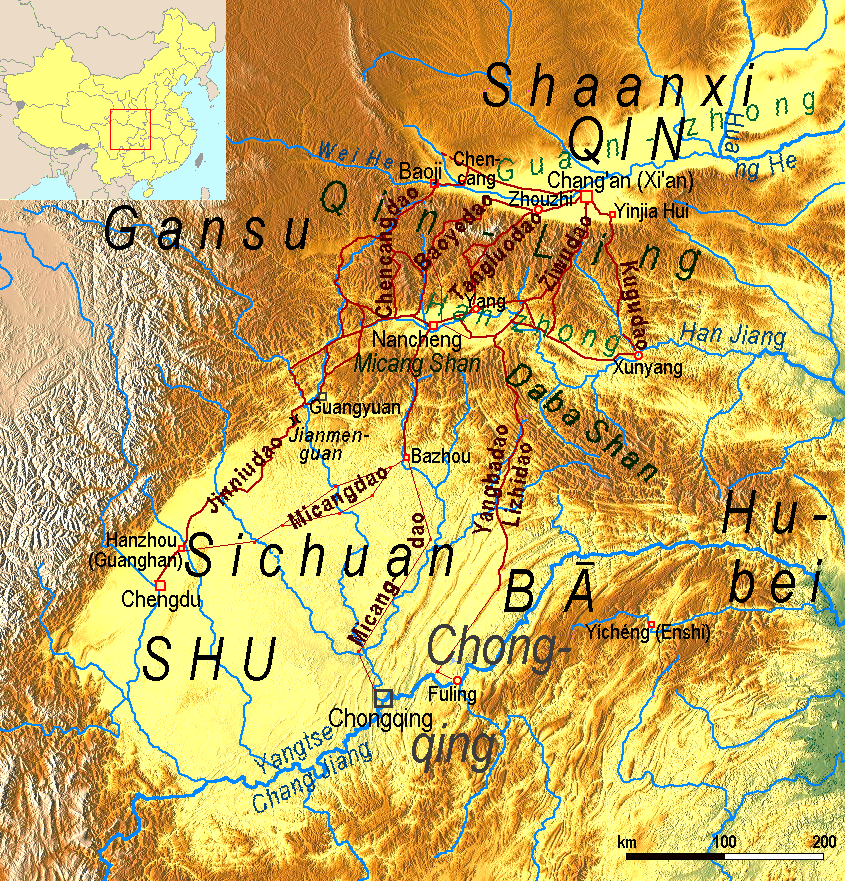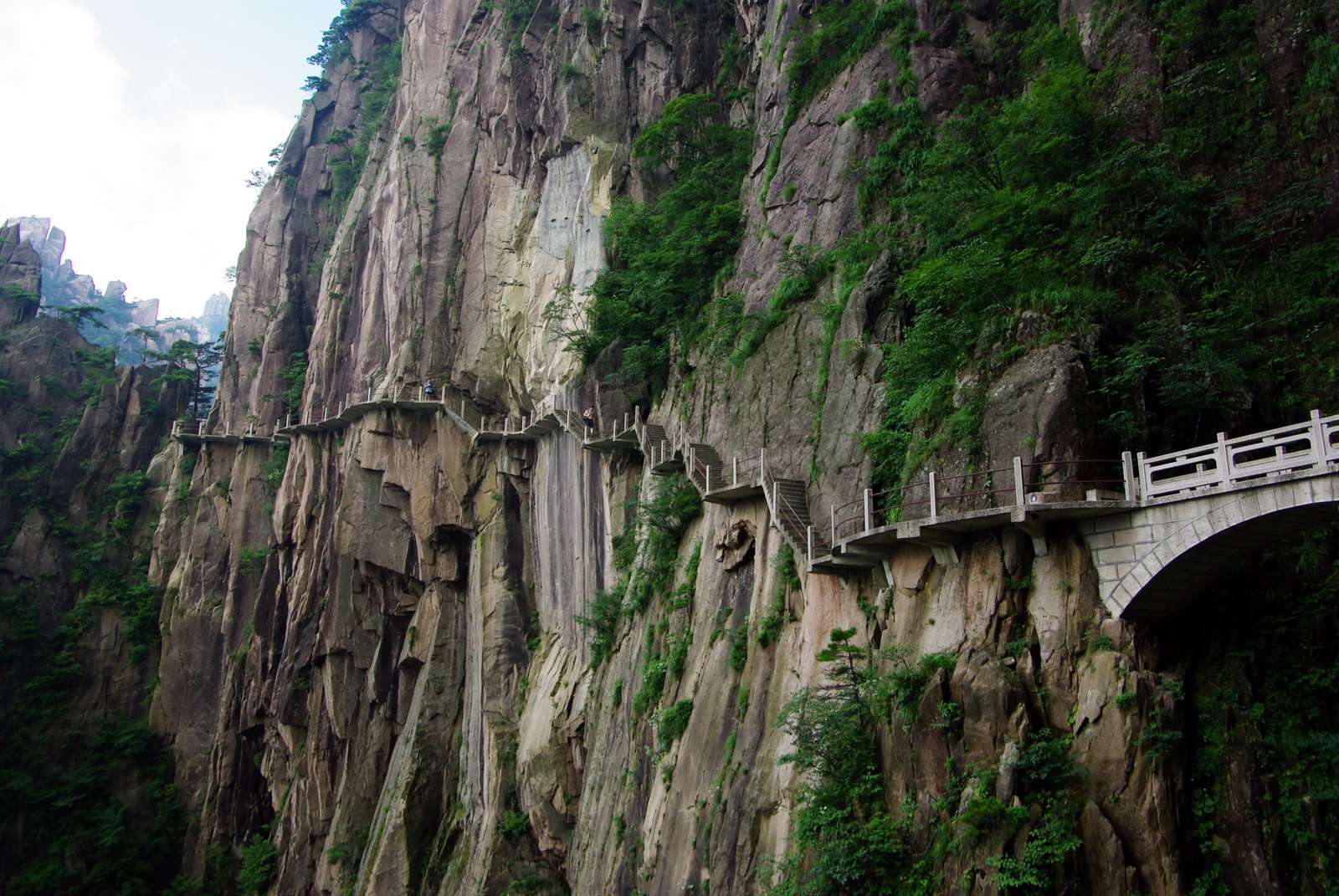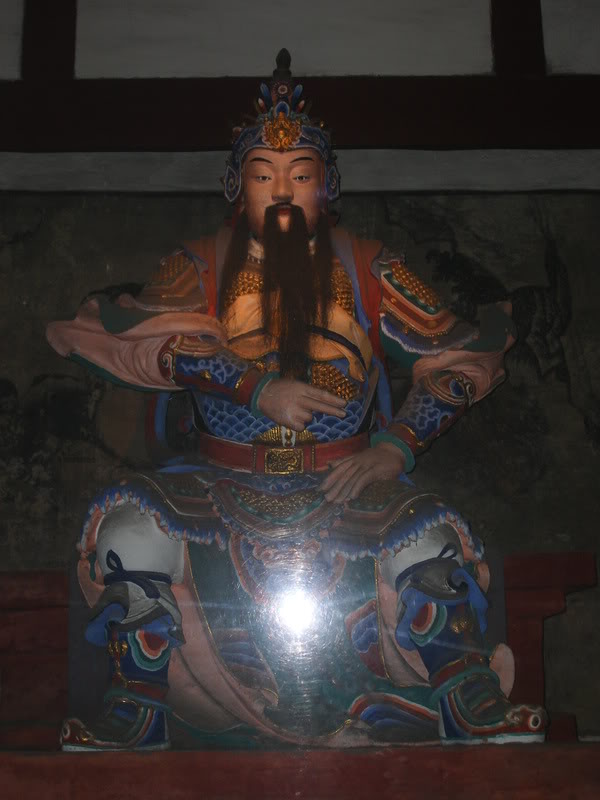|
Jianmen Pass
Jianmen Pass () is a mountain pass located southwest of the city of Guangyuan in Sichuan province. It has also been called "Jianmenguan Pass"; however, that form is redundant since ''guan'' means "pass" in Chinese. Location Jianmen Pass is located in Jiange County, Guangyuan City of Sichuan Province. The city of Chengdu, which is the capital of Sichuan Province, is less than 200 kilometers south from there. The natural pass is formed by cliffs on the sides of mountains. The gate of the pass was built on the middle part of the Dajian Mountain as a strategic position. History The mountain pass was a part of the Shu Roads. The construction of the gate was related to the Three Kingdoms era strategist, Shu Han chancellor Zhuge Liang. While Zhuge Liang repaired the gallery roads, he found the terrain in Jiange was a naturally perfect place to set up a defensive position for Shu; therefore, he ordered a military gate to be built on the pass. After Zhuge Liang died, his successor Jian ... [...More Info...] [...Related Items...] OR: [Wikipedia] [Google] [Baidu] |
Shudao
The Shudao (), or the Road(s) to Shu, is a system of mountain roads linking the Chinese province of Shaanxi with Sichuan (Shu), built and maintained since the 4th century BC. Technical highlights were the gallery roads, consisting of wooden planks erected on wooden or stone beams slotted into holes cut into the sides of cliffs. Geography The roads join three adjacent basins separated and surrounded by high mountains. The northern basin is called Guanzhong ("between the passes"). It is drained by the Yellow River. In ancient times it was the heart of the state of Qin, nowadays it is the central region of Shaanxi. To the south it is bounded by the Qinling Mountains. South of that range is the Hanzhong basin, drained by the Han River, a tributary of the Yangtze. The Hanzhong basin is divided from the Sichuan basin by mountain ranges called the Micang Shan (米倉山/米仓山, ''Mǐcāng Shān'', "Rice Granary Mountains") in the west and Daba Mountains in the east. The Sichuan ... [...More Info...] [...Related Items...] OR: [Wikipedia] [Google] [Baidu] |
Gallery Road
The archaeological gallery roads () were roads through remote mountain areas of China. They consisted of wooden planks erected on holes cut into the sides of cliffs. They were most notably used in the Qin Mountains linking the Wei River and the Han River valleys. The first gallery roads were built during the Warring States period (476-221 BC) and used by Qin to invade Shu and Ba. They were fully consolidated into a thriving network during the Han Dynasty. Before the 20th century, very primitive versions were used in the western gorges of the Pamir Mountains. Introduction Gallery road, also known as cliff road, plank road, is a creative building in Chinese history. The main use of the gallery road is to establish a traffic route over a cliff in a steep mountainous area. The Shu Road is the most typical representative. It passes through some of the most rugged and desolate terrains in China, such as the Qinling Mountains and the Daba Mountain ranges, linking the Wei river v ... [...More Info...] [...Related Items...] OR: [Wikipedia] [Google] [Baidu] |
Buildings And Structures In Sichuan
A building, or edifice, is an enclosed structure with a roof and walls standing more or less permanently in one place, such as a house or factory (although there's also portable buildings). Buildings come in a variety of sizes, shapes, and functions, and have been adapted throughout history for a wide number of factors, from building materials available, to weather conditions, land prices, ground conditions, specific uses, prestige, and aesthetic reasons. To better understand the term ''building'' compare the list of nonbuilding structures. Buildings serve several societal needs – primarily as shelter from weather, security, living space, privacy, to store belongings, and to comfortably live and work. A building as a shelter represents a physical division of the human habitat (a place of comfort and safety) and the ''outside'' (a place that at times may be harsh and harmful). Ever since the first cave paintings, buildings have also become objects or canvasses of much artistic ... [...More Info...] [...Related Items...] OR: [Wikipedia] [Google] [Baidu] |
Mountain Passes Of China
A mountain is an elevated portion of the Earth's crust, generally with steep sides that show significant exposed bedrock. Although definitions vary, a mountain may differ from a plateau in having a limited summit area, and is usually higher than a hill, typically rising at least 300 metres (1,000 feet) above the surrounding land. A few mountains are isolated summits, but most occur in mountain ranges. Mountains are formed through tectonic forces, erosion, or volcanism, which act on time scales of up to tens of millions of years. Once mountain building ceases, mountains are slowly leveled through the action of weathering, through slumping and other forms of mass wasting, as well as through erosion by rivers and glaciers. High elevations on mountains produce colder climates than at sea level at similar latitude. These colder climates strongly affect the ecosystems of mountains: different elevations have different plants and animals. Because of the less hospitable terrain and ... [...More Info...] [...Related Items...] OR: [Wikipedia] [Google] [Baidu] |
National Revolutionary Army
The National Revolutionary Army (NRA; ), sometimes shortened to Revolutionary Army () before 1928, and as National Army () after 1928, was the military arm of the Kuomintang (KMT, or the Chinese Nationalist Party) from 1925 until 1947 in China. It also became the regular army of the Republican era during the KMT's period of party rule beginning in 1928. It was renamed the Republic of China Armed Forces after the 1947 Constitution, which instituted civilian control of the military. Originally organized with Soviet aid as a means for the KMT to unify China during the Warlord Era, the National Revolutionary Army fought major engagements in the Northern Expedition against the Chinese Beiyang Army warlords, in the Second Sino-Japanese War (1937–1945) against the Imperial Japanese Army and in the Chinese Civil War against the People's Liberation Army. During the Second Sino-Japanese War, the armed forces of the Chinese Communist Party were nominally incorporated into the Nation ... [...More Info...] [...Related Items...] OR: [Wikipedia] [Google] [Baidu] |
People's Liberation Army
The People's Liberation Army (PLA) is the principal military force of the People's Republic of China and the armed wing of the Chinese Communist Party (CCP). The PLA consists of five service branches: the Ground Force, Navy, Air Force, Rocket Force, and Strategic Support Force. It is under the leadership of the Central Military Commission (CMC) with its chairman as commander-in-chief. The PLA can trace its origins during the Republican Era to the left-wing units of the National Revolutionary Army (NRA) of the Kuomintang (KMT) when they broke away on 1 August 1927 in an uprising against the nationalist government as the Chinese Red Army before being reintegrated into the NRA as units of New Fourth Army and Eighth Route Army during the Second Sino-Japanese War. The two NRA communist units were reconstituted into the PLA on 10 October 1947. Today, the majority of military units around the country are assigned to one of five theater commands by geographical location. ... [...More Info...] [...Related Items...] OR: [Wikipedia] [Google] [Baidu] |
Battle Of Jianmenguan
The Chengdu campaign was a campaign fought between the Communists and the Nationalists during the Chinese Civil War in the post World War II era and resulted in Communist victory and capture of Chengdu, national capital of the Republic of China and provincial capital of the southwestern Chinese province of Sichuan. The campaign was part of the Southwestern China campaign. Battle of Jianmenguan Jianmen Pass (Jianmen Guan, 剑门关) was one of the key gateways of Sichuan. There are 72 peaks in the range and the only road going through the mountains was 50 metres wide. Whoever controlled this 2 km long stretch of the road controlled the gateway of Sichuan, and the Nationalists had built an elaborate system of bunkers in the area to strengthen its defense against the expected communist invasion. After taking the city of Guangyuan on December 14, 1949, the communists decided that Jianmen Pass (Jianmen Guan, 剑门关) must be taken. The 540th Regiment of the 180th Division ... [...More Info...] [...Related Items...] OR: [Wikipedia] [Google] [Baidu] |
Chinese Civil War
The Chinese Civil War was fought between the Kuomintang-led government of the Republic of China and forces of the Chinese Communist Party, continuing intermittently since 1 August 1927 until 7 December 1949 with a Communist victory on mainland China. The war is generally divided into two phases with an interlude: from August 1927 to 1937, the KMT-CCP Alliance collapsed during the Northern Expedition, and the Nationalists controlled most of China. From 1937 to 1945, hostilities were mostly put on hold as the Second United Front fought the Japanese invasion of China with eventual help from the Allies of World War II, but even then co-operation between the KMT and CCP was minimal and armed clashes between them were common. Exacerbating the divisions within China further was that a puppet government, sponsored by Japan and nominally led by Wang Jingwei, was set up to nominally govern the parts of China under Japanese occupation. The civil war resumed as soon as it bec ... [...More Info...] [...Related Items...] OR: [Wikipedia] [Google] [Baidu] |
Ming Dynasty
The Ming dynasty (), officially the Great Ming, was an Dynasties in Chinese history, imperial dynasty of China, ruling from 1368 to 1644 following the collapse of the Mongol Empire, Mongol-led Yuan dynasty. The Ming dynasty was the last orthodox dynasty of China ruled by the Han Chinese, Han people, the majority ethnic group in China. Although the primary capital of Beijing fell in 1644 to a rebellion led by Li Zicheng (who established the short-lived Shun dynasty), numerous rump state, rump regimes ruled by remnants of the House of Zhu, Ming imperial family—collectively called the Southern Ming—survived until 1662. The Ming dynasty's founder, the Hongwu Emperor (r. 1368–1398), attempted to create a society of self-sufficient rural communities ordered in a rigid, immobile system that would guarantee and support a permanent class of soldiers for his dynasty: the empire's standing army exceeded one million troops and the naval history of China, navy's dockyards in Nanjin ... [...More Info...] [...Related Items...] OR: [Wikipedia] [Google] [Baidu] |
Cao Wei
Wei ( Hanzi: 魏; pinyin: ''Wèi'' < : *''ŋjweiC'' < : *''ŋuiC'') (220–266), known as Cao Wei or Former Wei in historiography, was one of the three major states that competed for supremacy over China in the period (220–280). With its capital initially located at , and thereafter |
Jiang Wei
Jiang Wei (202 – 3 March 264), courtesy name Boyue, was a military general of the state of Shu during the Three Kingdoms period of China. Born in Ji County (present-day Gangu County, Gansu), Jiang Wei started his career as a military officer in his native Tianshui Commandery, which was a territory of Wei. In 228, when Wei's rival state Shu launched an invasion led by Zhuge Liang, Jiang Wei was distrusted by Ma Zun, then administrator of Tianshui Commandery. As such, Jiang Wei had to defect to Shu. Zhuge Liang, the Imperial Chancellor and regent of Shu, highly regarded Jiang Wei and appointed him as a general in Shu. After Zhuge Liang's death in 234, Jiang Wei continued serving as a military commander during the regencies Jiang Wan and Fei Yi, eventually rising to the highest military rank of General-In-Chief (大將軍) after Fei Yi’s death in 253. Between 240 and 262, he continued Zhuge Liang's legacy of waging war against Wei by leading another 11 military campaigns. H ... [...More Info...] [...Related Items...] OR: [Wikipedia] [Google] [Baidu] |







.jpg)
